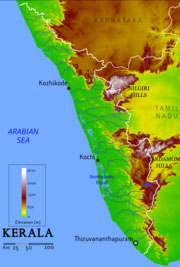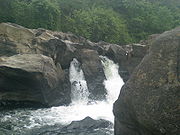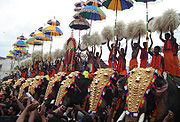Kerala is wedged between the Arabian Sea and the Western Ghats. Lying between north latitudes 8°18' and 12°48' and east longitudes 74°52' and 72°22', Kerala is well within the humid equatorial tropics. Kerala’s coast runs for some 580 km (360 miles), while the state itself varies between 35 and 120 km (22–75 miles) in width. Geographically, Kerala can be divided into three climatically distinct regions: the eastern highlands (rugged and cool mountainous terrain),  the central midlands (rolling hills), and the western lowlands (coastal plains). Located at the extreme southern tip of the Indian subcontinent, Kerala lies near the centre of the Indian tectonic plate; as such, most of the state is subject to comparatively little seismic and volcanic activity. Pre-Cambrian and Pleistocene geological formations compose the bulk of Kerala’s terrain the central midlands (rolling hills), and the western lowlands (coastal plains). Located at the extreme southern tip of the Indian subcontinent, Kerala lies near the centre of the Indian tectonic plate; as such, most of the state is subject to comparatively little seismic and volcanic activity. Pre-Cambrian and Pleistocene geological formations compose the bulk of Kerala’s terrain
Eastern Kerala consists of high mountains, gorges and deep-cut valleys immediately west of the Western Ghats' rain shadow. Forty one of Kerala’s west-flowing rivers, and three of its east-flowing ones originate in this region. The Western Ghats form a wall of mountains interrupted only near Palakkad, where the Palakkad Gap breaks through to provide access to the rest of India. The Western Ghats rises on average to 1,500 m (4920 ft) above sea level, while the highest peaks may reach to 2,500 m (8200 ft). Just west of the mountains lie the midland plains comprising central Kerala, dominated by rolling hills and valleys. Generally ranging between elevations of 250–1,000 m (820–3300 ft), the eastern portions of the Nilgiri and Palni Hills include such formations as Agastyamalai and Anamalai.
 Kerala’s western coastal belt is relatively flat, and is criss-crossed by a network of interconnected brackish canals, lakes, estuaries, and rivers known as the Kerala Backwaters. Lake Vembanad — Kerala’s largest body of water — dominates the Backwaters; it lies between Alappuzha and Kochi and is more than 200 km2 in area. Around 8% of India's waterways (measured by length) are found in Kerala. The most important of Kerala’s forty four rivers include the Periyar (244 km), the Bharathapuzha (209 km), the Pamba (176 km), the Chaliyar (169 km), the Kadalundipuzha (130 km) and the Achankovil (128 km). The average length of the rivers of Kerala is 64 km. Most of the remainder are small and entirely fed by monsoon rains. These conditions result in the nearly year-round water logging of such western regions as Kuttanad, 500 km2 of which lies below sea level. As Kerala's rivers are small and lack deltas, they are more prone to environmental factors. Kerala's rivers face many problems, including summer droughts, the building of large dams, sand mining, and pollution. Kerala’s western coastal belt is relatively flat, and is criss-crossed by a network of interconnected brackish canals, lakes, estuaries, and rivers known as the Kerala Backwaters. Lake Vembanad — Kerala’s largest body of water — dominates the Backwaters; it lies between Alappuzha and Kochi and is more than 200 km2 in area. Around 8% of India's waterways (measured by length) are found in Kerala. The most important of Kerala’s forty four rivers include the Periyar (244 km), the Bharathapuzha (209 km), the Pamba (176 km), the Chaliyar (169 km), the Kadalundipuzha (130 km) and the Achankovil (128 km). The average length of the rivers of Kerala is 64 km. Most of the remainder are small and entirely fed by monsoon rains. These conditions result in the nearly year-round water logging of such western regions as Kuttanad, 500 km2 of which lies below sea level. As Kerala's rivers are small and lack deltas, they are more prone to environmental factors. Kerala's rivers face many problems, including summer droughts, the building of large dams, sand mining, and pollution.
|
 the central midlands (rolling hills), and the western lowlands (coastal plains). Located at the extreme southern tip of the Indian subcontinent, Kerala lies near the centre of the Indian tectonic plate; as such, most of the state is subject to comparatively little seismic and volcanic activity. Pre-Cambrian and Pleistocene geological formations compose the bulk of Kerala’s terrain
the central midlands (rolling hills), and the western lowlands (coastal plains). Located at the extreme southern tip of the Indian subcontinent, Kerala lies near the centre of the Indian tectonic plate; as such, most of the state is subject to comparatively little seismic and volcanic activity. Pre-Cambrian and Pleistocene geological formations compose the bulk of Kerala’s terrain Kerala’s western coastal belt is relatively flat, and is criss-crossed by a network of interconnected brackish canals, lakes, estuaries, and rivers known as the Kerala Backwaters. Lake Vembanad — Kerala’s largest body of water — dominates the Backwaters; it lies between Alappuzha and Kochi and is more than 200 km2 in area. Around 8% of India's waterways (measured by length) are found in Kerala. The most important of Kerala’s forty four rivers include the Periyar (244 km), the Bharathapuzha (209 km), the Pamba (176 km), the Chaliyar (169 km), the Kadalundipuzha (130 km) and the Achankovil (128 km). The average length of the rivers of Kerala is 64 km. Most of the remainder are small and entirely fed by monsoon rains. These conditions result in the nearly year-round water logging of such western regions as Kuttanad, 500 km2 of which lies below sea level. As Kerala's rivers are small and lack deltas, they are more prone to environmental factors. Kerala's rivers face many problems, including summer droughts, the building of large dams, sand mining, and pollution.
Kerala’s western coastal belt is relatively flat, and is criss-crossed by a network of interconnected brackish canals, lakes, estuaries, and rivers known as the Kerala Backwaters. Lake Vembanad — Kerala’s largest body of water — dominates the Backwaters; it lies between Alappuzha and Kochi and is more than 200 km2 in area. Around 8% of India's waterways (measured by length) are found in Kerala. The most important of Kerala’s forty four rivers include the Periyar (244 km), the Bharathapuzha (209 km), the Pamba (176 km), the Chaliyar (169 km), the Kadalundipuzha (130 km) and the Achankovil (128 km). The average length of the rivers of Kerala is 64 km. Most of the remainder are small and entirely fed by monsoon rains. These conditions result in the nearly year-round water logging of such western regions as Kuttanad, 500 km2 of which lies below sea level. As Kerala's rivers are small and lack deltas, they are more prone to environmental factors. Kerala's rivers face many problems, including summer droughts, the building of large dams, sand mining, and pollution.

